锂离子电池的优点
锂离子动力电池的优势与劣势分析
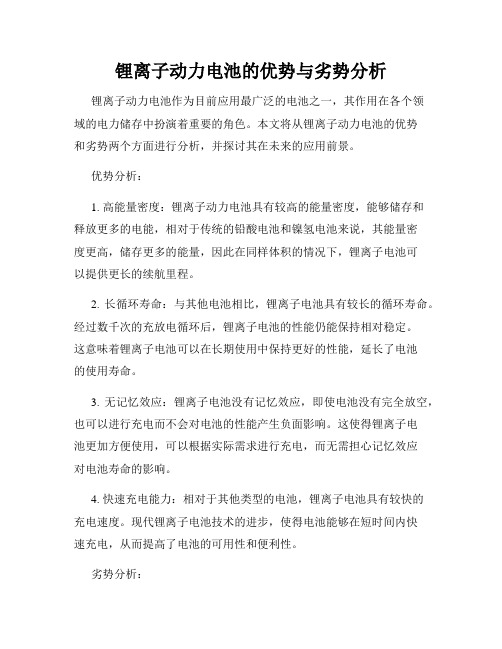
锂离子动力电池的优势与劣势分析锂离子动力电池作为目前应用最广泛的电池之一,其作用在各个领域的电力储存中扮演着重要的角色。
本文将从锂离子动力电池的优势和劣势两个方面进行分析,并探讨其在未来的应用前景。
优势分析:1. 高能量密度:锂离子动力电池具有较高的能量密度,能够储存和释放更多的电能,相对于传统的铅酸电池和镍氢电池来说,其能量密度更高,储存更多的能量,因此在同样体积的情况下,锂离子电池可以提供更长的续航里程。
2. 长循环寿命:与其他电池相比,锂离子电池具有较长的循环寿命。
经过数千次的充放电循环后,锂离子电池的性能仍能保持相对稳定。
这意味着锂离子电池可以在长期使用中保持更好的性能,延长了电池的使用寿命。
3. 无记忆效应:锂离子电池没有记忆效应,即使电池没有完全放空,也可以进行充电而不会对电池的性能产生负面影响。
这使得锂离子电池更加方便使用,可以根据实际需求进行充电,而无需担心记忆效应对电池寿命的影响。
4. 快速充电能力:相对于其他类型的电池,锂离子电池具有较快的充电速度。
现代锂离子电池技术的进步,使得电池能够在短时间内快速充电,从而提高了电池的可用性和便利性。
劣势分析:1. 安全性问题:锂离子电池在过热、过充、过放等情况下,存在安全隐患。
如果电池内部结构设计不当,或者电池过度使用时发生异常,可能会导致电池膨胀、起火甚至爆炸等安全事故。
因此,在设计和使用锂离子电池时需要特别注意安全问题,并采取相应的安全措施。
2. 有限的资源和环境影响:锂离子电池的生产需要消耗大量的锂资源,而目前全球锂资源的储量有限。
此外,电池的生产和废弃处理也会对环境造成一定的影响。
虽然一些回收技术正在发展,但对于大规模的电池废弃物处理仍然存在问题。
3. 电池容量衰退:锂离子电池的容量随着使用时间的增加而逐渐下降。
这是因为电池内部材料的物理和化学变化,导致电池容量减少。
尽管锂离子电池相对其他电池类型的容量衰减较慢,但随着使用寿命的延长,容量衰减仍然是影响锂离子电池性能的一个因素。
锂离子电池的优点

锂离子电池的优点1)能量密度高。
能量密度可达460-600Wh/kg,其能量密度是铅酸电池的6-7倍;2)相对较高的平均输出电压值。
常用的锂离子电池单体平均工作电压约为3.7V,约为镍-隔电池或者镍-氢电池的3倍3)可以高功率输出,在电动汽车的磷酸铁锂离子电池可以达到15-30C充放电能量,有利于启动加速;4)相对较小的自放电率,无记忆效应,锂电池的自放电率为镍-隔电池或者镍-氢电池的一半甚至更小。
记忆效应指的是电池在充放电循环过程中容量减小的现象,而锂离子电池在循环过程中不出现明显地容量衰减现象;5)使用寿命长,在正常条件下,锂离子电池使用寿命可达6年,循环次数超过1000次。
(6)可快速充电,使用额定电压为4.2 V的充电器只需1~2小时即可充满(7)使用温度范围宽,通常可在-30~+45℃温度范围内使用,通过调整电解液甚至可以在更宽温度范围内使用;(8)绿色电池,对环境友好,无论生产、使用和报废,都不存在镉、铅、汞等对环境有污染的元素;Figure 4b shows the typical charge−discharge voltage profiles of the S@CNTs/Co3S4−NBs, S@Co3S4−NBs and S@CNTs electrodes at 0.2 C (1.0 C = 1,675 mAh g−1). The S@CNTs/ Co3S4−NBs electrode exhibits two typical discharge plateaus at 2.35 and 2.08 V (vs Li+/Li), originated from the reduction of S8 to soluble long-chain polysulfides (Li2Sx, 4 ≤ x ≤ 8) and the formation of insoluble short-chain polysulfides (Li2S/Li2S2), respectively. The single charge plateau of S@CNTs/Co3S4−NBs between 2.25−2.36 V is ascribed to the oxidation of Li2S/ Li2S2 to Li2Sx and eventually S8. These charge and discharge plateaus are consistent with corresponding CV curves (Figure S5). Notably, the S@CNTs/Co3S4−NBs electrode exhibits lower potential hysteresis and higher sulfur utilization ratio than those of the S@Co3S4−NBs and S@CNTs, mainly attributed to the strong chemical affinity of polar Co3S4−NBs with polysulfides and the interconnected CNT network.图4b 显示了S@CNTs/Co3S4−NBs、S@Co3S4−NBs 和S@CNTs 电极在0.2 c (1.0 c = 1675 麻将g−1)上的典型charge−discharge 电压剖面。
简述锂离子电池的优点

简述锂离子电池的优点介绍锂离子电池锂离子电池是一种常用的可充电电池,其通过锂离子在正负极之间的往返转移来实现储存和释放电能。
它具有很多优点,使得它成为目前最广泛使用的电池技术之一。
高能量密度•锂离子电池具有高能量密度,意味着它可以存储更多的电能。
这使得它非常适合用于移动设备,如智能手机、笔记本电脑和电动车。
高能量密度意味着设备可以更长时间地工作,而不需要频繁充电。
长寿命•锂离子电池具有较长的使用寿命。
它们通常可以经受数百到数千次的充放电循环,而仍然能保持高容量。
这使得锂离子电池成为可靠的能源储备选择。
此外,锂离子电池的自放电率非常低,即使在长时间不使用时,也能保持较长时间的电荷。
快速充电速度•锂离子电池具有较短的充电时间。
相比其他可充电电池,锂离子电池可以在相对较短的时间内达到较高的充电水平。
这对于用户来说是非常方便的,可以在短时间内重新使用他们的设备。
低自放电率•一个显著的优点是锂离子电池的自放电率很低。
这意味着即使你暂时不使用电池,它也会保持电荷状态相对长时间。
相比于其他电池类型,锂离子电池拥有更长的储存时间,这使得它们特别适用于备用电源和紧急情况。
环保友好•锂离子电池是一种环保友好的电池技术。
相比传统的一次性碱性电池,锂离子电池可以重复使用,并且无需频繁更换。
这减少了电池废弃物的排放,有利于环境保护。
轻便易携带•锂离子电池具有较轻的重量和较小的体积。
这使得它们成为很多移动设备的理想能源选择。
相比其他电池技术,锂离子电池带来更轻巧的设备设计和更好的便携性。
高效能源转换•锂离子电池具有较高的能源转换效率。
它们能够将电能转换为可用能源的百分比较高,这意味着它们能够更有效地利用储存的能量。
这使得锂离子电池成为可靠的能源选择,尤其是对于需要长时间使用能量密集型设备的用户。
安全性•锂离子电池具有较高的安全性。
通过采用先进的保护措施和控制系统,锂离子电池可以避免过充、过放和过载等问题。
这使得锂离子电池在使用过程中更加稳定和可靠,降低了火灾和爆炸的风险。
简述锂离子电池的优点

锂离子电池的优点1. 高能量密度锂离子电池是目前市场上最常见的可充电电池之一,其最大的优点之一就是高能量密度。
相比于其他类型的可充电电池,锂离子电池能够储存更多的能量,使得设备在同样体积和重量下可以拥有更长的使用时间。
这对于便携设备如手机、笔记本电脑和无人机等来说尤为重要。
2. 长周期寿命锂离子电池具有较长的循环寿命,可以进行数百次的充放电循环而不会显著损失容量。
相比之下,其他类型的可充电电池如镍氢电池和铅酸蓄电池在循环寿命方面表现较差。
这意味着锂离子电池可以更持久地供应能源,减少了更换和维修的频率。
3. 低自放电率自放电率是指在不使用状态下,储存能量时所损失的速率。
锂离子电池具有较低的自放电率,这意味着即使长时间不使用也能保持较高的电量。
相比之下,其他类型的可充电电池如镍镉电池和镍氢电池具有更高的自放电率,需要更频繁地进行充电。
4. 无记忆效应记忆效应是指当重复进行不完全充放电时,电池的容量会逐渐降低。
锂离子电池几乎没有记忆效应,可以随时进行充放电而不会对容量产生明显影响。
这使得锂离子电池更加方便使用,用户不必担心特定的充放电模式。
5. 快速充电能力锂离子电池具有较好的快速充电能力。
相比于其他类型的可充电电池,锂离子电池可以在较短时间内完成充电过程。
这对于用户来说非常方便,尤其是在急需使用设备但是电量不足时。
6. 环保和可回收性与传统的一次性碱性或铅酸蓄电池相比,锂离子电池具有更好的环保性能。
它们可以被多次充放电使用,减少了废弃物产生。
在正确处理和回收的情况下,锂离子电池的材料可以被有效回收和再利用,减少了对有限资源的依赖。
7. 较低的自燃风险相比于其他类型的可充电电池,锂离子电池具有较低的自燃风险。
这是由于锂离子电池使用了非常稳定和安全的化学物质作为电解液和正负极材料。
然而,在不正确使用或处理的情况下,锂离子电池仍然可能发生自燃事故,因此用户应该遵守正确的使用和处理指南。
8. 可定制性锂离子电池可以根据不同应用的需求进行定制设计。
简述锂离子电池的特点

简述锂离子电池的特点
锂离子电池是一种高能量电池,主要用于电动和便携设备。
它的特点
如下:
1.高能量密度:锂离子电池的能量密度是传统镍氢电池和镍镉电池的
两倍以上,使其成为便携式电子设备中的理想选择。
同时,它也是电动汽
车的主要能源之一。
2.长寿命:锂离子电池的寿命通常可以达到数年甚至十年以上,而铅
酸电池和镍氢电池的寿命相对较短。
3.充电方便:锂离子电池可以通过各种方式进行充电,包括插电充电
和无线充电等。
同时,它也支持快速充电,从而节省时间并提高效率。
4.环保:锂离子电池不包含有害物质,因此对环境没有负面影响。
5.轻量化:锂离子电池的体积和重量相对较小,可在体积和重量限制
的设备中应用广泛。
6.无“内存效应”:锂离子电池不存在“内存效应”,即当电池充电时,它的容量和电能会被减少。
这意味着锂离子电池可以在任何时间充电。
7.较低的自放电率:锂离子电池的自放电率较低,意味着即使在未使
用的情况下,电池也可以保持其电荷数天甚至数周。
总的来说,锂离子电池具有高能量密度、长寿命、充电方便、环保、
轻量化、无“内存效应”以及较低的自放电率等优点。
这些特点使得它成
为便携式电子设备、电动汽车等众多领域中的理想能源选择。
电动汽车锂电池的优点介绍

电动汽车锂电池的优点介绍电动车电池分铅酸电池和锂离子电池,相对于电动车的铅酸电池而言,我们对锂电动车的锂离子电池了解的更少,下面我们简单介绍一下锂离子电池的十大优点。
1、循环寿命长:锂离子电池以1C倍率进行充、放电,其循环寿命大于等于500次,第500次时的电容量,大于标称铜梁70%。
而铅酸电池即使以0.5放电,以0.15C以充电,其循环寿命小于等于350次,电容量小于等于60%。
2、低温度放电性能好:锂离子电池可在-25度时正常工作,其电容量可达标称容量的70%,而铅酸电池在-10度时的电容量的50%,在-25度时不:能正常工作。
3、荷电保持能力强:将充满电的锂离子电池组,放置两个月后,其电容量大于等于80%,而铅酸电池放置两个月,仅为标称容量的40%-50%。
4、续行能力强,由于锂离子电池组的重量仅为铅酸电池的30%,因此在相同的电压,电容量下,锂离子电池的续行能力强。
5、比能量高:由于锂离子电池的体积仅为铅酸电池的30%,因此当使用相同的空间时锂离子电池的能量储备比铅酸电池大。
6、工作温度范围宽:锂离子电池可在-25度到55度范围内工作,而铅酸电池只能在10度到40度范围内工作。
7、充电时间短:由于锂离子电池具有可大电流充电的特性,因此充电时间只要4-5小时,而铅酸电池则需要8至10小时。
8、绿色环保性能高:与铅酸电池拥有大量对人体,环境有害的重金属铅相比,锂离子电池是高环保型的产品。
9、可以大电流放电:锂离子电池在1C倍率下大电流放电,其容量仅为额定电容量60%。
10、大电流放电不影响循环寿命:锂离子电池以1.5C倍率下大电流放电,对其循环寿命毫无影响。
而铅酸电池在1.5C 倍率下大电流放电。
其循环寿命仅为标称循环寿命30%-40%。
锂离子电池的特性与优势

锂离子电池的特性与优势如今,对于UPS供电系统来说,采用锂离子电池的初始资本支出仅为铅酸蓄电池的1.4倍,但采用锂离子电池10年的总体拥有成本(TCO)可以节省10%-30%。
锂离子电池的优点包括:1、可靠性和可用性由于锂离子电池与铅酸电池的制造方法不同,锂离子电池故障率要低得多。
由于使用寿命更长,维护要求更低,UPS电源采用锂离子电池很少发生故障。
根据所使用的化学成分,锂离子电池的使用寿命可长达15年。
与铅酸蓄电池相比,可以显著节省更换成本,因为锂离子电池不必每隔几年更换一次。
此外,锂离子电池通常比铅酸电池具有更长的循环寿命。
例如,铅酸蓄电池通常可以提供200次放电循环,这意味着可以将电池的容量耗尽至其额定值的50%,然后其重新充电至100%,可以达到200次循环。
但在更换电池之前,锂电池可以提供500-7000次放电循环(这取决于所使用的化学物质)。
另外,锂离子电池具有较低的自放电率,或者在不使用时自身放电缓慢,这使得它们具有更长的保存时间。
2、重量较轻锂离子电池比铅酸蓄电池重约三分之一。
这样可以节省数据中心建设成本,因为不需要加固地板来承受更多的重量。
它还节省了运输成本,因为与铅酸蓄电池相比,能够以同样的成本运输更多的锂离子电池。
3、更小的体积锂离子电池柜的尺寸通常是铅酸电池柜的一半,达到相同的容量可节省50%的占地面积。
这使组织可以重新规划设计数据中心,以增加IT系统的可用空间。
此外,可以节省新数据中心的建设成本,因为容纳用于UPS储能的锂离子电池机柜的空间可以更小。
4、能量密度更高锂电池具有更高的能量密度(Wh/kg,或每千克瓦特小时)和功率密度(W/kg,或每千克瓦特)。
这就是为什么锂电池能够以更小的体积和更轻的重量提供与铅酸蓄电池相同能量的原因。
5、工作在温度较高的环境锂电池可以在86°F(30°C)的温度下工作,比铅酸蓄电池高出近10°C。
这使组织可以提高数据中心的室温,从而节省用于冷却的电能,降低冷却成本,节省总体拥有成本(TCO)。
锂离子电池的优缺点

东 莞 轩 航 电 子 有 限 公 司Dongguan ShineHong Electronics Co., LTD. ADD : 中国广东省东莞市长安镇长盛社区荟萃街33号金秋楼501室 第 1 页 共 1 页锂离子电池的优缺点一、 优点:1) 电压高,单体电池的工作电压高达3.6-3.9V ,是Ni-Cd 、Ni-H 电池的3倍2) 比能量大,目前能达到的实际比能量为100-125Wh/kg 和240-300Wh/L (2倍于Ni-Cd ,1.5倍于Ni-MH ),未来随着技术发展,比能量可高达150Wh/kg 和400 Wh/L3) 循环寿命长,一般均可达到500次以上,甚至1000次以上.对于小电流放电的电器,电池的使用期限 将倍增电器的竞争力.4) 安全性能好,无公害,无记忆效应.作为Li-ion 前身的锂电池,因金属锂易形成枝晶发生短路,缩减了其应用领域:Li-ion 中不含镉、铅、汞等对环境有污染的元素:部分工艺(如烧结式)的Ni-Cd 电池存在的一大弊病为“记忆效应”,严重束缚电池的使用,但Li-ion 根本不存在这方面的问题。
5) 自放电小,室温下充满电的Li-ion 储存1个月后的自放电率为10%左右,大大低于Ni-Cd 的25-30%,Ni 、MH 的30-35%。
6) 可快速充放电,1C 充电是容量可以达到标称容量的80%以上。
7) 工作温度范围高,工作温度为-25~45°C,随着电解质和正极的改进,期望能扩宽到-40~70°C。
二、 锂离子电池也存在着一定的缺点,如:1) 电池成本较高。
主要表现在正极材料LiCoO2的价格高(Co 的资源较少),电解质体系提纯困难。
2) 不能大电流放电。
由于有机电解质体系等原因,电池内阻相对其他类电池大。
故要求较小的放电电流密度,一般放电电流在0.5C 以下,只适合于中小电流的电器使用。
3) 需要保护线路控制。
A 、过充保护:电池过充将破坏正极结构而影响性能和寿命;同时过充电使电解液分解,内部压力过高而导致漏液等问题;故必须在4.1V-4.2V 的恒压下充电;4) B 、过放保护:过放会导致活性物质的恢复困难,故也需要有保护线路控制。
锂离子电池的优缺点

锂离子电池的优缺点导语:随着科技的不断进步,锂离子电池作为一种重要的电池技术,在现代社会中得到了广泛的应用和重视。
本文将从能量密度、充放电性能、环境友好性、成本和安全性等方面探讨锂离子电池的优缺点。
一、优点:1. 高能量密度:锂离子电池相比于传统的铅酸电池和镍镉电池具有更高的能量密度。
这意味着同样体积和重量的锂离子电池能够储存更多的能量,为电动汽车、便携设备和太阳能等领域的发展提供了支持。
2. 良好的充放电性能:锂离子电池具有较高的充放电效率和较长的循环寿命。
相比于镍镉电池和镍氢电池,锂离子电池的内阻较低,充电速度较快,并且能够经受较多次的充放电过程而不损失很多容量。
3. 环境友好性:锂离子电池不含有重金属污染物,类似于铅酸电池和镍镉电池中的有害物质。
这使得锂离子电池具有较低的污染风险,并且可以更好地符合环保要求。
二、缺点:1. 成本较高:锂离子电池的制造成本相对较高,这主要是因为其所需材料的昂贵以及制造过程中的技术复杂性。
尽管随着技术不断进步,锂离子电池的成本正在逐渐下降,但仍然相对较高。
2. 安全性问题:锂离子电池存在一定的安全隐患。
由于锂离子电池采用液体电解质,高温、过度充电或物理损伤可能导致电池过热、短路和甚至起火爆炸。
因此,对于锂离子电池的设计和使用需要严格的安全措施。
3. 衰减问题:锂离子电池在长时间使用后会逐渐衰减,即容量会随着循环次数的增加而减少。
这个问题对于需要长时间使用的设备和车辆来说可能是一个挑战,需要通过优化设计和改进电池材料来解决。
结论:综上所述,锂离子电池作为一种重要的电池技术,有其独特的优点和缺点。
虽然存在一些安全和成本问题,但锂离子电池的高能量密度、良好的充放电性能和环境友好性使其在电动汽车、便携设备和可再生能源等领域具有巨大的潜力。
我们期待未来的科技发展能够进一步解决这些问题,使锂离子电池更加安全、稳定和可靠。
锂离子电池和钠离子电池

锂离子电池和钠离子电池
锂离子电池和钠离子电池,是一种新型的重要电池技术,两者在性能、使用、维护等方面有很大的不同。
一、锂离子电池
1. 优点:
(1)拥有更高的能量密度,能够从单位容量施加的电压中获得的能量更多。
(2)电池的失效率低,使用寿命长。
(3)电池具有较高的循环使用能力,可以达到多次充电放电。
(4)电池放电平缓,不会出现强烈的抖动,这也显示了他的抗干扰能力。
(5)电池运行稳定,不会由于冰点效应而出现负偏移,能够更好的长时间的提供能量。
2. 缺点:
(1)电池的体积相对较大,承受负载电流大时,会出现温升快。
(2)由于结构的复杂,生产制作的难度相对较大,所以生产的成本也比较高。
二、钠离子电池
1. 优点:
(1)电池的放电容量相对大,能够提供足量的能量。
(2)电池具有较高的耐压性和耐冲击性。
(3)电池的制备成本很低,灵活应用于各种不同的化学反应中。
(4)钠离子电池具有极好的适应性,可以适应室温,没有额外的功率损失,并且能够节省空间。
2. 缺点:
(1)电池的性能有限,特别是充放电性能不好。
(2)电池的恒容耐受性低,不能对特定的要求快速应答。
(3)电池的循环寿命短,其电容量在放电和充电过程中会受到影响。
总的来说,锂离子电池和钠离子电池的主要区别在于能量密度、使用
寿命、循环使用能力、充放电性能及制作成本,使得它们在各自的应
用领域具有不同的优势。
而且,两者在安全性和环境友好性方面也有
不同。
国家自然科学基金 锂离子电池
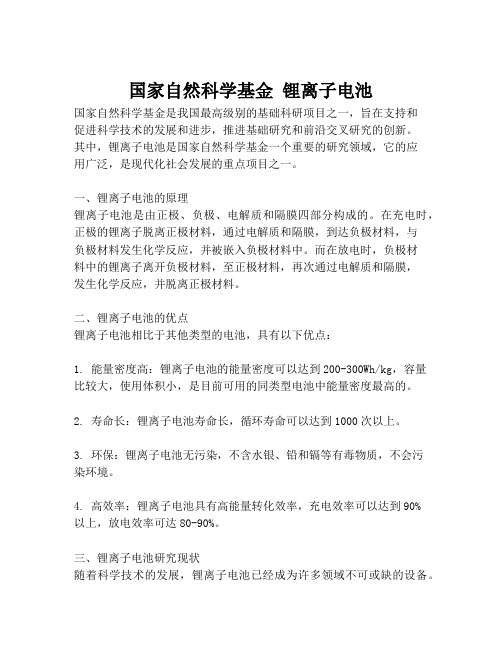
国家自然科学基金锂离子电池国家自然科学基金是我国最高级别的基础科研项目之一,旨在支持和促进科学技术的发展和进步,推进基础研究和前沿交叉研究的创新。
其中,锂离子电池是国家自然科学基金一个重要的研究领域,它的应用广泛,是现代化社会发展的重点项目之一。
一、锂离子电池的原理锂离子电池是由正极、负极、电解质和隔膜四部分构成的。
在充电时,正极的锂离子脱离正极材料,通过电解质和隔膜,到达负极材料,与负极材料发生化学反应,并被嵌入负极材料中。
而在放电时,负极材料中的锂离子离开负极材料,至正极材料,再次通过电解质和隔膜,发生化学反应,并脱离正极材料。
二、锂离子电池的优点锂离子电池相比于其他类型的电池,具有以下优点:1. 能量密度高:锂离子电池的能量密度可以达到200-300Wh/kg,容量比较大,使用体积小,是目前可用的同类型电池中能量密度最高的。
2. 寿命长:锂离子电池寿命长,循环寿命可以达到1000次以上。
3. 环保:锂离子电池无污染,不含水银、铅和镉等有毒物质,不会污染环境。
4. 高效率:锂离子电池具有高能量转化效率,充电效率可以达到90%以上,放电效率可达80-90%。
三、锂离子电池研究现状随着科学技术的发展,锂离子电池已经成为许多领域不可或缺的设备。
在我国,越来越多的科研团队投入到锂离子电池的研究中,不断探索提高电池性能的方法。
目前,锂离子电池研究的主要方向包括:1. 正极材料:锂离子电池正极材料直接影响电池性能,目前主要研究领域包括镍基、锰基、钴基、铁基、磷酸铁锂等正极材料。
2. 负极材料:负极材料对锂离子的嵌入与脱出过程至关重要,目前主要研究领域包括石墨、硅等负极材料。
3. 电解质:电池性能与电解液的性质密切相关,目前主要研究领域包括液态电解质、固态电解质等。
4. 稳定性:锂离子电池的稳定性是影响其使用寿命最为关键的因素之一,目前重点研究防止电池爆炸和电池寿命长的方法。
四、结论随着国家自然科学基金和科学技术的发展,锂离子电池的研究将会朝着更高效、更安全、更稳定、更环保的方向不断发展,其应用也将会在越来越多的领域得到应用。
锂电池的优缺点
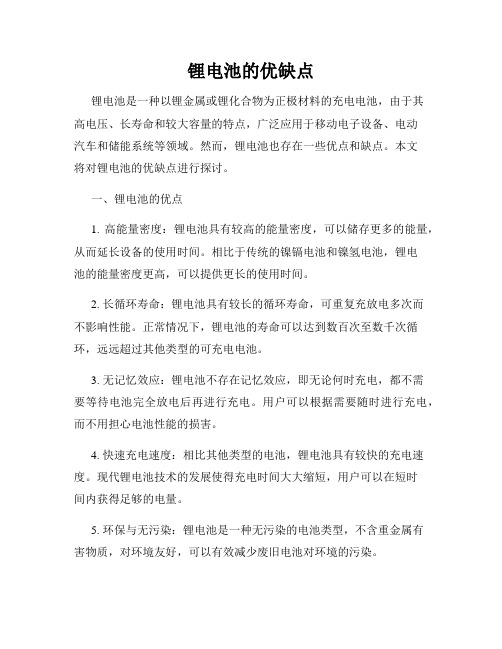
锂电池的优缺点锂电池是一种以锂金属或锂化合物为正极材料的充电电池,由于其高电压、长寿命和较大容量的特点,广泛应用于移动电子设备、电动汽车和储能系统等领域。
然而,锂电池也存在一些优点和缺点。
本文将对锂电池的优缺点进行探讨。
一、锂电池的优点1. 高能量密度:锂电池具有较高的能量密度,可以储存更多的能量,从而延长设备的使用时间。
相比于传统的镍镉电池和镍氢电池,锂电池的能量密度更高,可以提供更长的使用时间。
2. 长循环寿命:锂电池具有较长的循环寿命,可重复充放电多次而不影响性能。
正常情况下,锂电池的寿命可以达到数百次至数千次循环,远远超过其他类型的可充电电池。
3. 无记忆效应:锂电池不存在记忆效应,即无论何时充电,都不需要等待电池完全放电后再进行充电。
用户可以根据需要随时进行充电,而不用担心电池性能的损害。
4. 快速充电速度:相比其他类型的电池,锂电池具有较快的充电速度。
现代锂电池技术的发展使得充电时间大大缩短,用户可以在短时间内获得足够的电量。
5. 环保与无污染:锂电池是一种无污染的电池类型,不含重金属有害物质,对环境友好,可以有效减少废旧电池对环境的污染。
二、锂电池的缺点1. 安全风险:锂电池的高能量密度也带来了一定的安全风险。
如果使用不当、损坏或过热,锂电池有可能发生短路、过充、过放等问题,甚至可能引发火灾或爆炸。
因此,正确的使用和储存锂电池非常重要。
2. 高成本:相比于其他类型的电池,锂电池的成本较高。
主要原因是锂电池的材料和制造工艺相对复杂,导致生产成本较高。
虽然随着技术的改进和市场的扩大,锂电池的价格有所下降,但仍然比传统电池更昂贵。
3. 有限的资源:锂是一种有限资源,主要集中在少数国家和地区。
锂电池的大规模应用对锂资源的需求会越来越高,可能导致供需不平衡和资源的过度开采。
4. 衰减与容量衰退:锂电池使用一段时间后,其容量会逐渐衰减。
这意味着锂电池的使用寿命会随着时间的推移而缩短,并需要更频繁地进行充电。
简述锂离子电池的优点和缺点

简述锂离子电池的优点和缺点锂离子电池是一种常见的充电电池,广泛应用于移动设备、电动车辆和储能系统等领域。
它具有以下优点和缺点。
优点:1. 高能量密度:锂离子电池具有较高的能量密度,即单位重量或体积可以储存更多的电能。
这使得它成为移动设备和电动车辆等领域的理想选择,因为它可以提供更长的使用时间或续航里程。
2. 长循环寿命:锂离子电池具有较长的循环寿命,能够进行数千次的充放电循环而不明显衰减。
相比之下,其他类型的电池,如镍镉电池和镍氢电池,在相同的使用条件下循环寿命较短。
3. 无记忆效应:锂离子电池没有记忆效应,即在充电前不需要完全放空电池,也可以进行充电。
这使得使用和维护锂离子电池更加方便。
4. 低自放电率:锂离子电池的自放电率相对较低,即在长时间存储或未使用时,电池的电量损失较小。
这使得锂离子电池成为备用电池或应急电源的理想选择。
5. 环保友好:锂离子电池不含有有害物质,如铅、汞等重金属,相比其他类型的电池更环保。
同时,锂离子电池可以进行回收和再利用,减少了对环境的影响。
缺点:1. 安全风险:锂离子电池在过充、过放、高温、短路等情况下存在安全风险。
过度充电或过度放电可能导致电池的氧化物分解,产生热量和气体,甚至引发火灾或爆炸。
因此,锂离子电池需要严格的电池管理系统和安全保护措施。
2. 有限的寿命:锂离子电池的寿命是有限的,随着使用时间的增加,电池的性能会逐渐下降。
这主要是由于电池内部化学反应的不可逆性导致的,最终需要更换电池。
3. 充电时间较长:相比其他类型的电池,锂离子电池的充电时间较长。
这是由于锂离子电池的充电过程需要较为缓慢的充电速率,以确保电池的安全和寿命。
4. 成本较高:锂离子电池的制造成本相对较高,这主要是由于其复杂的制造工艺和材料成本所致。
因此,锂离子电池的价格较高,这可能会限制其在某些应用领域的普及和推广。
锂离子电池具有高能量密度、长循环寿命、无记忆效应、低自放电率和环保友好等优点,但也存在安全风险、有限的寿命、充电时间较长和成本较高等缺点。
锂电池的优缺点
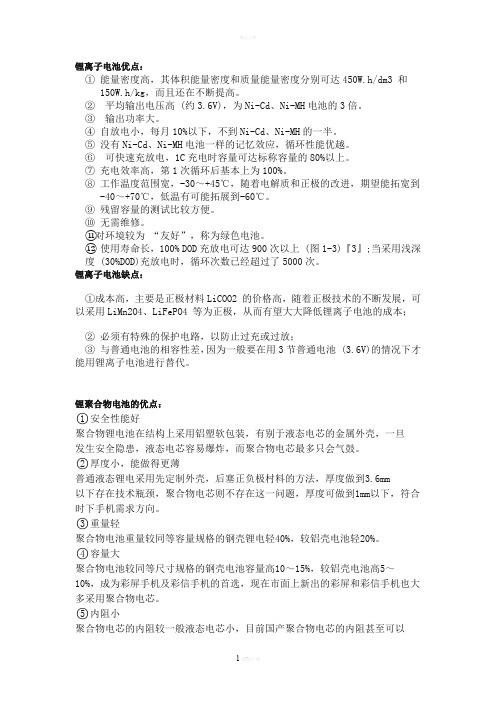
锂离子电池优点:①能量密度高,其体积能量密度和质量能量密度分别可达450W.h/dm3 和150W.h/kg,而且还在不断提高。
②平均输出电压高 (约3.6V),为Ni-Cd、Ni-MH电池的3倍。
③输出功率大。
④自放电小,每月10%以下,不到Ni-Cd、Ni-MH的一半。
⑤没有Ni-Cd、Ni-MH电池一样的记忆效应,循环性能优越。
⑥可快速充放电,1C充电时容量可达标称容量的80%以上。
⑦充电效率高,第1次循环后基本上为100%。
⑧工作温度范围宽,-30~+45℃,随着电解质和正极的改进,期望能拓宽到-40~+70℃,低温有可能拓展到-60℃。
⑨残留容量的测试比较方便。
⑩无需维修。
⑪对环境较为“友好”,称为绿色电池。
⑫使用寿命长,100% DOD充放电可达900次以上 (图1-3)『3』;当采用浅深度 (30%DOD)充放电时,循环次数已经超过了5000次。
锂离子电池缺点:①成本高,主要是正极材料LiCOO2 的价格高,随着正极技术的不断发展,可以采用LiMn2O4、LiFePO4 等为正极,从而有望大大降低锂离子电池的成本;②必须有特殊的保护电路,以防止过充或过放;③与普通电池的相容性差,因为一般要在用3节普通电池 (3.6V)的情况下才能用锂离子电池进行替代。
锂聚合物电池的优点:○1安全性能好聚合物锂电池在结构上采用铝塑软包装,有别于液态电芯的金属外壳,一旦发生安全隐患,液态电芯容易爆炸,而聚合物电芯最多只会气鼓。
○2厚度小,能做得更薄普通液态锂电采用先定制外壳,后塞正负极村料的方法,厚度做到3.6mm以下存在技术瓶颈,聚合物电芯则不存在这一问题,厚度可做到1mm以下,符合时下手机需求方向。
○3重量轻聚合物电池重量较同等容量规格的钢壳锂电轻40%,较铝壳电池轻20%。
○4容量大聚合物电池较同等尺寸规格的钢壳电池容量高10~15%,较铝壳电池高5~10%,成为彩屏手机及彩信手机的首选,现在市面上新出的彩屏和彩信手机也大多采用聚合物电芯。
锂离子电池的优缺点分析
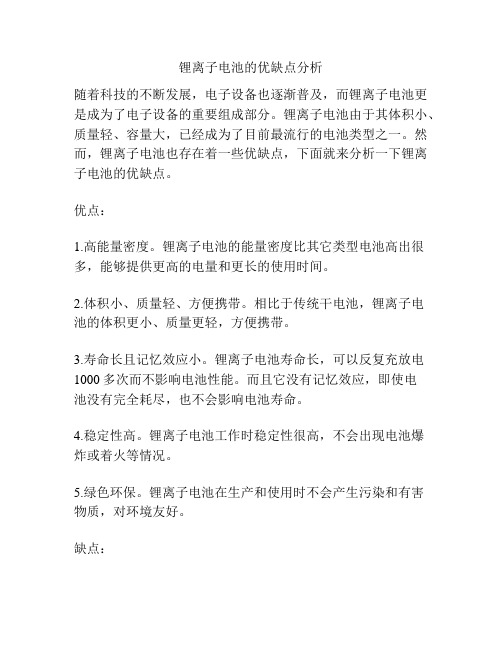
锂离子电池的优缺点分析随着科技的不断发展,电子设备也逐渐普及,而锂离子电池更是成为了电子设备的重要组成部分。
锂离子电池由于其体积小、质量轻、容量大,已经成为了目前最流行的电池类型之一。
然而,锂离子电池也存在着一些优缺点,下面就来分析一下锂离子电池的优缺点。
优点:1.高能量密度。
锂离子电池的能量密度比其它类型电池高出很多,能够提供更高的电量和更长的使用时间。
2.体积小、质量轻、方便携带。
相比于传统干电池,锂离子电池的体积更小、质量更轻,方便携带。
3.寿命长且记忆效应小。
锂离子电池寿命长,可以反复充放电1000多次而不影响电池性能。
而且它没有记忆效应,即使电池没有完全耗尽,也不会影响电池寿命。
4.稳定性高。
锂离子电池工作时稳定性很高,不会出现电池爆炸或着火等情况。
5.绿色环保。
锂离子电池在生产和使用时不会产生污染和有害物质,对环境友好。
缺点:1.价格高昂。
锂离子电池的生产成本比其它类型电池高,因此价格也较贵。
2.容量下降难以恢复。
如果锂离子电池使用过程中容量下降,通常难以通过充电等方式恢复。
3.容易受高温影响。
锂离子电池工作时会产生一些热量,在高温环境中易受损。
4.安全性存在隐患。
锂离子电池一旦受到严重损坏,如挤压、碎裂等就容易发生爆炸或着火等安全问题。
5.充电时间长。
锂离子电池充电时间比其它电池类型长,需要较长时间才能充满。
综上所述,锂离子电池具有容量大、使用寿命长、体积小等优点,但价格较贵,容易受高温和受损等缺点,因此在使用过程中需要注意安全问题,并且避免在高温环境中使用。
总之,锂离子电池是一种不可或缺的电子设备能量来源,但在使用中需要充分了解其优缺点,合理使用。
随着科技的不断进步,电子设备的使用场景和需求越来越多样化,因此锂离子电池也在不断地发展和创新,展现出更加广阔的前景和更高的应用价值。
1.环保性和可持续发展现今,环保和可持续发展已成为全球的主要趋势,越来越多的电池厂商致力于开发和生产环保型锂电池。
锂离子电池的性能优势和缺点总结
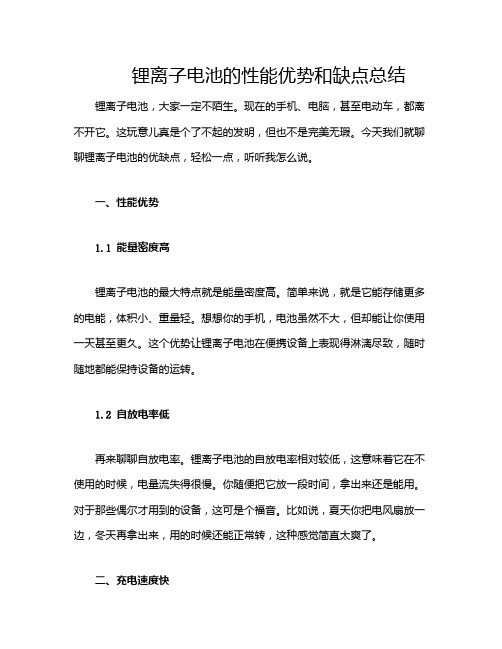
锂离子电池的性能优势和缺点总结锂离子电池,大家一定不陌生。
现在的手机、电脑,甚至电动车,都离不开它。
这玩意儿真是个了不起的发明,但也不是完美无瑕。
今天我们就聊聊锂离子电池的优缺点,轻松一点,听听我怎么说。
一、性能优势1.1 能量密度高锂离子电池的最大特点就是能量密度高。
简单来说,就是它能存储更多的电能,体积小、重量轻。
想想你的手机,电池虽然不大,但却能让你使用一天甚至更久。
这个优势让锂离子电池在便携设备上表现得淋漓尽致,随时随地都能保持设备的运转。
1.2 自放电率低再来聊聊自放电率。
锂离子电池的自放电率相对较低,这意味着它在不使用的时候,电量流失得很慢。
你随便把它放一段时间,拿出来还是能用。
对于那些偶尔才用到的设备,这可是个福音。
比如说,夏天你把电风扇放一边,冬天再拿出来,用的时候还能正常转,这种感觉简直太爽了。
二、充电速度快2.1 充电便利锂离子电池的另一个大优点就是充电速度快。
大家应该都不喜欢等,尤其是等电池充电。
锂离子电池可以在短时间内充满电,甚至半小时就能充到八九成。
这点对于忙碌的现代人来说,真是太有用了。
无论是赶飞机还是上班前急着充电,快就是王道。
2.2 循环寿命长再说说循环寿命。
锂离子电池的循环寿命一般可以达到几百到上千次,这样一来,使用寿命就比许多其他电池长得多。
你买个手机,电池用个三四年都没问题。
这样的耐用性,不仅让我们省心,也减少了电子废物的产生,真是一举两得。
2.3 适应温度广锂离子电池的适应温度范围也相对较广,能在零下和高温的环境中稳定工作。
这点尤其适合在各种恶劣环境下使用,比如户外探险、极地考察等。
想象一下,冰天雪地里,能依然有电,真是让人倍感安心。
三、缺点3.1 成本高不过,锂离子电池也不是没有缺点。
首先就是成本高。
这种电池的生产材料和工艺都比较复杂,所以价格相对较贵。
虽然现在市场上已经有了很多更便宜的选择,但想要高性能的锂离子电池,还是得花点银子。
特别是电动车的电池,价格可不是一般的贵,真是让人心疼。
- 1、下载文档前请自行甄别文档内容的完整性,平台不提供额外的编辑、内容补充、找答案等附加服务。
- 2、"仅部分预览"的文档,不可在线预览部分如存在完整性等问题,可反馈申请退款(可完整预览的文档不适用该条件!)。
- 3、如文档侵犯您的权益,请联系客服反馈,我们会尽快为您处理(人工客服工作时间:9:00-18:30)。
锂离子电池的优点1)能量密度高。
能量密度可达460-600Wh/kg,其能量密度是铅酸电池的6-7倍;2)相对较高的平均输出电压值。
常用的锂离子电池单体平均工作电压约为3.7V,约为镍-隔电池或者镍-氢电池的3倍3)可以高功率输出,在电动汽车的磷酸铁锂离子电池可以达到15-30C充放电能量,有利于启动加速;4)相对较小的自放电率,无记忆效应,锂电池的自放电率为镍-隔电池或者镍-氢电池的一半甚至更小。
记忆效应指的是电池在充放电循环过程中容量减小的现象,而锂离子电池在循环过程中不出现明显地容量衰减现象;5)使用寿命长,在正常条件下,锂离子电池使用寿命可达6年,循环次数超过1000次。
(6)可快速充电,使用额定电压为4.2 V的充电器只需1~2小时即可充满(7)使用温度范围宽,通常可在-30~+45℃温度范围内使用,通过调整电解液甚至可以在更宽温度范围内使用;(8)绿色电池,对环境友好,无论生产、使用和报废,都不存在镉、铅、汞等对环境有污染的元素;Figure 4b shows the typical charge−discharge voltage profiles of the S@CNTs/Co3S4−NBs, S@Co3S4−NBs and S@CNTs electrodes at 0.2 C (1.0 C = 1,675 mAh g−1). The S@CNTs/ Co3S4−NBs electrode exhibits two typical discharge plateaus at 2.35 and 2.08 V (vs Li+/Li), originated from the reduction of S8 to soluble long-chain polysulfides (Li2Sx, 4 ≤ x ≤ 8) and the formation of insoluble short-chain polysulfides (Li2S/Li2S2), respectively. The single charge plateau of S@CNTs/Co3S4−NBs between 2.25−2.36 V is ascribed to the oxidation of Li2S/ Li2S2 to Li2Sx and eventually S8. These charge and discharge plateaus are consistent with corresponding CV curves (Figure S5). Notably, the S@CNTs/Co3S4−NBs electrode exhibits lower potential hysteresis and higher sulfur utilization ratio than those of the S@Co3S4−NBs and S@CNTs, mainly attributed to the strong chemical affinity of polar Co3S4−NBs with polysulfides and the interconnected CNT network.图4b 显示了S@CNTs/Co3S4−NBs、S@Co3S4−NBs 和S@CNTs 电极在0.2 c (1.0 c = 1675 麻将g−1)上的典型charge−discharge 电压剖面。
S@CNTs/Co3S4−NBs电极展示两个典型的放电高原在 2.35 和 2.08 V (vs li +/李), 起源于 S8 的减少到可溶性长链多硫化物 (Li2Sx, 4 ≤ x ≤ 8) 和形成不溶性短链多硫化物 (Li2S/Li2S2),分别.2.25−2.36 V 之间S@CNTs/Co3S4−的单电荷高原归因于Li2S/Li2S2 对Li2Sx 和最终S8 的氧化作用。
这些电荷和放电高原与相应的CV 曲线一致(图S5)。
值得注意的是, S@CNTs/Co3S4−NBs电极具有比S@Co3S4−NBs和 S@CNTs 更低的潜在滞后率和较高的硫利用率,主要归因于极Co3S4−NBs与多硫化物的强烈化学亲和性和互联的碳纳米管网络。
The rate capability comparison of S@CNTs/Co3S4−NBs,S@Co3S4−NBs, S@CNTs, and S@mixed-CNTs&Co3S4−NBs(the sulfur composite of simply mixed CNTs and Co3S4−NBs)is shown in Figure 4d and Figure S6. When cycled at 0.2, 0.5,1.0, 2.0, and 5.0 C, the S@CNTs/Co3S4−NBs cathode candeliver impressive discharge capacities of 1330, 1165, 988, 859,and 702 mAh g−1, respectively. As the current density turnsback to 1.0 C, the discharge capacity of S@CNTs/Co3S4−NBsrestores to 958 mAh g−1, indicating good structural stability athigh rate. In contrast, the discharge capacities of S@Co3S4−NBs cathode fades sharply from 1240 to 268 mAh g−1 when therate increases from 0.2 to 2.0 C. What is more, the dischargecapacity of S@CNTs fades dramatically to 37 mAh g−1 whenthe current rate increases to 5.0 C. It is clear that the S@CNTs/Co3S4−NBs cathode exhibits much higher ratecapabilities than those of S@Co3S4−NBs and S@CNTs. Thegalvanostatic charge−discharge voltage profiles ofthe S@CNTs/Co3S4−NBs cathode at various current rates were alsomeasured (Figure 4e). The results confirm that theincorporation of interlaced CNT network is very helpful toimprove the rate capability of S@CNTs/Co3S4−NBs. Moreover,the localized and overall electron transfer of the sulfurspecies trapped in S@CNTs/Co3S4−NBs can be effectivelyfacilitated by the interconnected CNT network inserted in andthreaded between the Co3S4−NBs (Figure S7).Synthesis of Hollow Iron Phosphide Nanoparticles. [Caution: Thisreaction should be considered to be highly corrosive andflammable because the high-temperature decomposition of aphosphine can liberate phosphorus, which is pyrophoric. Therefore,this reaction should only be carried out using rigorouslyair-free conditions by appropriately trained personnel.] Hollowiron phosphide nanoparticles were synthesized from colloidaliron nanoparticles by slightly modifying a previously reportedprocess.24 1-Octadecene (ODE, 10.0 mL, 31.3 mmol) andoleylamine (0.2 mL, 0.61 mmol) were added to a 50 mL, threenecked,round-bottom flask that was equipped with a refluxcondenser, a thermometer adapter, a thermometer, a rubberseptum, and a borosilicate-coated stir bar. The contents of theflask were stirred and heated to 120 Cunder vacuum for 30 minto remove any adventitious water and then placed under anAr atmosphere. This ODE/oleylamine solution was then heatedto 190 C, at which point 0.35 mL of pentacarbonyliron wasinjected. The suspension was then maintained at 190 C for20 min. Five milliliters of the hot ODE/oleylamine mixture, whichat this point now contained colloidal Fe nanoparticles, wasthen rapidly injected (using a glass syringe) into a secondAr-filled 50 mL, three-necked flask containing squalane(7.0 mL, 13 mmol) and tri-n-octylphosphine (3.0 mL, 6.7 mmol)that had been heated to 340 C for 1 h. The temperaturedropped as a result of the injection and was brought back upto 320 C and held at that temperature for 1 h. After the reactionwas completed, the heating mantle was turned off and thesolution was allowed to cool to 200 C. The heating mantle wasthen removed to allow the sample to cool more rapidly to roomtemperature. The reaction solution was divided into two centrifugetubes for collection and cleaning. The nanoparticleswere collected by adding hexanes (5 mL) and ethanol (15 mL)to each tube, followed by centrifugation (12 000 rpm, 3 min).The particles were then resuspended in hexanes (5 mL), and thisprocess was repeated twice more. Nanoparticles were redispersedin hexanes after isolation and placed in a vial (20 mL)for use.。
